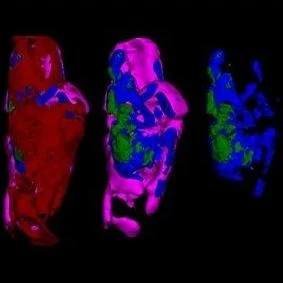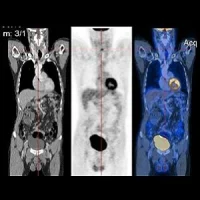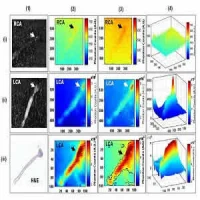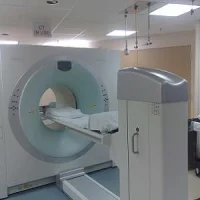University of Cambridge researchers have developed an imaging technique — combining positron emission tomography (PET) and CT — that uses sodium fluoride radiotracer to detect the build-up of unstable calcium deposits in arteries, a process that can cause heart attack and stroke. The new method, reported in the journal Nature Communications, could help in the diagnosis of these conditions in high-risk patients and in the development of new medicines.
Atherosclerosis (hardening of the arteries) is a potentially serious condition where arteries become clogged by a build-up of fatty deposits known as ‘plaques’. One of the key constituents in these deposits is calcium. In some people, pieces from the calcified artery can break away. When this happens, the artery supplies the heart or brain with blood, which can lead to heart attack or stroke.
For this study, researchers injected patients with sodium fluoride that had been tagged with a tiny amount of a radioactive tracer. Using a combination of PET and CT scanning techniques, the researchers were able to track the progress of the tracer as it moved around the body.
“Sodium fluoride is commonly found in toothpaste as it binds to calcium compounds in our teeth’s enamel,” explains Dr. Anthony Davenport from the Department of Experimental Medicine and Immunotherapeutics at the University of Cambridge, who led the study. “In a similar way, it also binds to unstable areas of calcification in arteries and so we’re able to see, by measuring the levels of radioactivity, exactly where the deposits are building up. In fact, this new emerging technique is the only imaging platform that can non-invasively detect the early stages of calcification in unstable atherosclerosis.”
Following their sodium fluoride scans, the patients had surgery to remove calcified plaques and the extracted tissue was imaged, this time at higher resolution, using a laboratory PET/CT scanner and an electron microscope. This confirmed that the radiotracer accumulates in areas of active, unstable calcification whilst avoiding surrounding tissue, according to researchers.
The new imaging technique "will allow us to use current treatments more effectively, by giving them to those patients at highest risk," notes Dr. James Rudd, a cardiologist and researcher from the Department of Cardiovascular Medicine at the University of Cambridge. After further work, Dr. Rudd says it may be possible to use this technique to test how well new medicines perform at preventing the development of atherosclerosis.
Source and image credit: University of Cambridge
Atherosclerosis (hardening of the arteries) is a potentially serious condition where arteries become clogged by a build-up of fatty deposits known as ‘plaques’. One of the key constituents in these deposits is calcium. In some people, pieces from the calcified artery can break away. When this happens, the artery supplies the heart or brain with blood, which can lead to heart attack or stroke.
For this study, researchers injected patients with sodium fluoride that had been tagged with a tiny amount of a radioactive tracer. Using a combination of PET and CT scanning techniques, the researchers were able to track the progress of the tracer as it moved around the body.
“Sodium fluoride is commonly found in toothpaste as it binds to calcium compounds in our teeth’s enamel,” explains Dr. Anthony Davenport from the Department of Experimental Medicine and Immunotherapeutics at the University of Cambridge, who led the study. “In a similar way, it also binds to unstable areas of calcification in arteries and so we’re able to see, by measuring the levels of radioactivity, exactly where the deposits are building up. In fact, this new emerging technique is the only imaging platform that can non-invasively detect the early stages of calcification in unstable atherosclerosis.”
Following their sodium fluoride scans, the patients had surgery to remove calcified plaques and the extracted tissue was imaged, this time at higher resolution, using a laboratory PET/CT scanner and an electron microscope. This confirmed that the radiotracer accumulates in areas of active, unstable calcification whilst avoiding surrounding tissue, according to researchers.
The new imaging technique "will allow us to use current treatments more effectively, by giving them to those patients at highest risk," notes Dr. James Rudd, a cardiologist and researcher from the Department of Cardiovascular Medicine at the University of Cambridge. After further work, Dr. Rudd says it may be possible to use this technique to test how well new medicines perform at preventing the development of atherosclerosis.
Source and image credit: University of Cambridge
References:
Rudd JH, Davenport AP et al. (2015) Identifying active vascular microcalcification by 18F-sodium fluoride positron emission tomography.
Nature Communications, 07 July 2015 doi: 10.1038/ncomms8495
Latest Articles
healthmanagement, atherosclerosis, arterial plaque, sodium fluoride, calcification, PET-CT
University of Cambridge researchers have developed an imaging technique — combining positron emission tomography (PET) and CT — that uses sodium fluoride radiotracer to detect the build-up of unstable calcium deposits in arteries.










